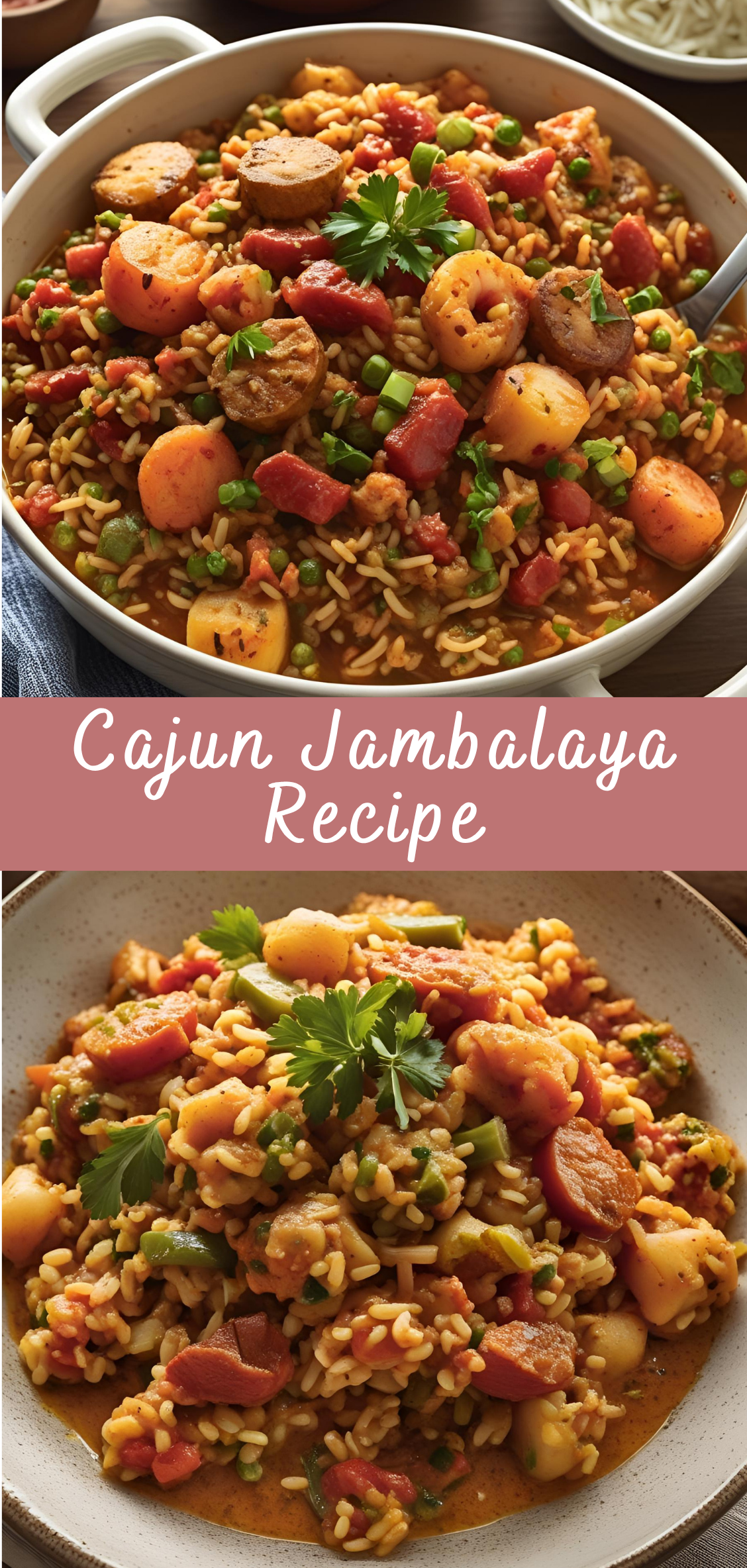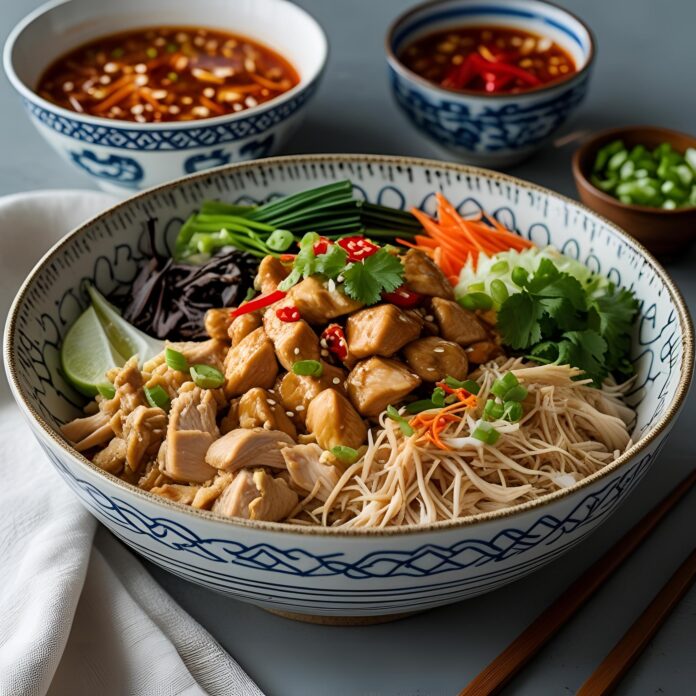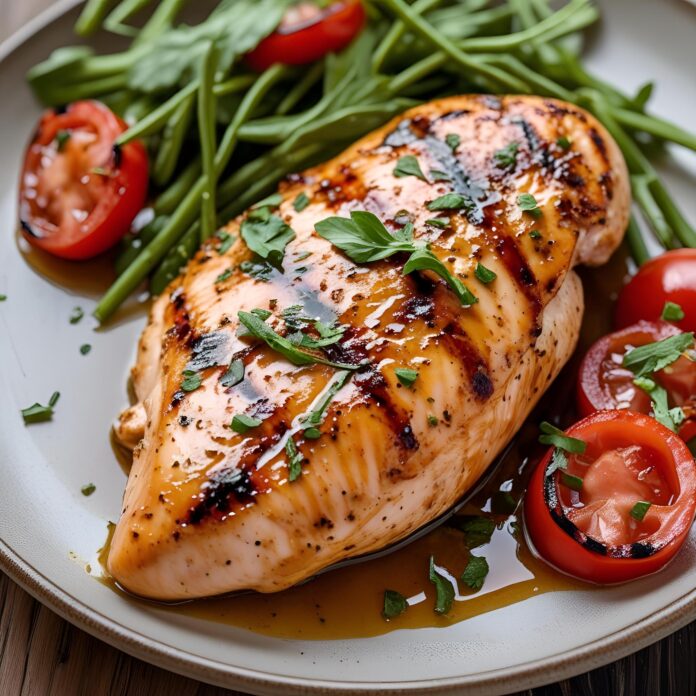Cajun Jambalaya Recipe
Jambalaya isn’t just a dish — it’s a celebration. A bold, aromatic, one-pot symphony of meat, vegetables, rice, and spice, it captures the essence of Louisiana’s Cajun culture in every bite. It’s rustic, it’s rich, and it’s deeply rooted in a tradition of cooking that values resourcefulness, community, and flavor that tells a story. From humble kitchens to festive family gatherings, Cajun Jambalaya has stood the test of time, carrying with it a legacy of adaptation, heritage, and heart.

At its core, Cajun Jambalaya is a dish of transformation. It begins with simple ingredients — onions, bell peppers, celery, rice, and stock — but when combined with a smoky sausage, seasoned chicken, perhaps shrimp or crawfish, and the signature Cajun spice blend, it becomes something truly magical. The process is layered and intentional: meats are browned to deepen the flavor, vegetables are sautéed to form the holy trinity base, spices are toasted to bloom their aromas, and everything is simmered together until the rice is tender and infused with savory richness.
Unlike its Creole cousin, which often includes tomatoes and leans toward New Orleans influence, Cajun Jambalaya is a reflection of the rural bayou — darker, drier, and smokier. The color comes from carefully browned meat and caramelized vegetables, not tomato paste. The flavor leans toward the earthier, more peppery notes of Cajun spice blends, with generous use of paprika, garlic, thyme, and cayenne.
But make no mistake: while tradition is respected, Jambalaya welcomes interpretation. Some families guard their recipes like heirlooms, passed from generation to generation without a single change. Others embrace experimentation, adding new proteins, substituting grains, or adjusting spice levels to match modern preferences. It’s this adaptability — without ever losing its soul — that has kept Cajun Jambalaya so beloved across kitchens of all kinds.
In this extensive guide, we’ll take you deep into the art and science of making an unforgettable Cajun Jambalaya. We’ll walk through every ingredient choice, cooking technique, and flavor-building strategy, from choosing the right sausage and understanding the spice balance to perfecting rice texture and troubleshooting common mistakes. We’ll also explore the cultural roots of the dish, its evolution across Louisiana, and how it compares to other one-pot classics from around the world.
Whether you’re cooking for the first time or refining your family’s version, this recipe is designed to give you the knowledge and confidence to master Cajun Jambalaya — and to make it your own. Because while the ingredients are important, what truly makes Jambalaya special is how it brings people together — around the stove, at the table, and in celebration of bold, soulful food.
Detailed Instructions: How to Make Authentic Cajun Jambalaya
This is a rustic, one-pot dish with roots in necessity, but don’t be fooled by its humble appearance — when done properly, Cajun Jambalaya delivers an unforgettable combination of textures, spices, and smoky, savory depth. The key to success is patience, preparation, and heat control.
Step 1: Gather and Prep Ingredients
First, gather and prepare all ingredients before turning on the heat. Cajun Jambalaya moves quickly once it starts, and mise en place (everything in place) is essential for a smooth cooking process.
Proteins:
-
1 lb (450 g) smoked andouille sausage, sliced into 1/4-inch rounds
-
1 lb (450 g) boneless, skinless chicken thighs or breasts, cut into 1-inch cubes
-
1/2 lb (225 g) shrimp, peeled and deveined (optional, added near the end)
Aromatics and Vegetables:
-
1 large yellow onion, finely chopped
-
1 bell pepper (green or red), diced
-
2 celery stalks, diced
-
4 cloves garlic, minced
-
2 green onions, thinly sliced (for garnish)
-
Fresh parsley, chopped (for garnish)
Dry Spices (Cajun Seasoning Blend):
-
1 ½ teaspoons paprika (smoked, if available)
-
1 teaspoon garlic powder
-
1 teaspoon onion powder
-
½ teaspoon cayenne pepper (adjust to taste)
-
1 teaspoon dried thyme
-
1 teaspoon dried oregano
-
½ teaspoon black pepper
-
1 ½ teaspoons kosher salt (adjust later)
Other Ingredients:
-
1 ½ cups long-grain white rice, uncooked
-
3 ½ cups low-sodium chicken stock or broth
-
2 tablespoons vegetable oil (or bacon fat, for extra flavor)
-
Optional: 1 tablespoon Worcestershire sauce or hot sauce for depth
Step 2: Brown the Meat — Layer One of Flavor
Start building flavor by properly browning the proteins. This not only adds depth, but also develops fond — the brown bits on the bottom of the pot — which is essential for the dish’s signature richness.
Chicken First:
-
Heat a large heavy-bottomed pot (like a Dutch oven) over medium-high heat. Add 1 tablespoon of oil.
-
Add the chicken in a single layer — don’t crowd the pot. Sear until golden brown on all sides but not fully cooked through, about 4–5 minutes. Remove and set aside.
Sausage Second:
-
Add the sliced andouille sausage to the same pot (add a touch more oil if needed).
-
Sauté until the sausage is well-browned and starting to crisp, about 5–6 minutes. This step renders fat and builds flavor.
-
Remove and set aside with the chicken.
Tip: Do not wipe the pot between steps — all the browned bits stuck to the bottom will be deglazed later for added flavor.
Step 3: Build the Holy Trinity (Cajun Mirepoix)
Now you’ll start the vegetable base: a trio of onion, celery, and bell pepper, often referred to as the “Holy Trinity” in Cajun and Creole cooking.
-
Reduce heat to medium. Add another tablespoon of oil if the pan looks dry.
-
Add the chopped onion, bell pepper, and celery. Sauté for 7–10 minutes, stirring frequently, until the vegetables are soft, slightly browned, and fragrant.
-
Add the garlic and cook for 1 more minute, just until fragrant — avoid burning.
Optional Enhancement: Add a splash (about 2 tablespoons) of Worcestershire sauce or a touch of hot sauce here to boost umami and complexity.
Step 4: Toast the Spices
To bring out the full power of your Cajun seasoning, toast the spices directly in the hot pan.
-
Sprinkle in the paprika, cayenne, garlic powder, onion powder, thyme, oregano, black pepper, and salt.
-
Stir constantly for 30–45 seconds. You’ll smell the difference — the spices will become more aromatic and complex.
Why this works: Dry toasting spices in oil awakens fat-soluble flavor compounds and prevents a “raw spice” taste.
Step 5: Add the Rice and Deglaze
-
Stir in the uncooked rice, coating it thoroughly in the spice mixture and oil. Toast for 2–3 minutes, stirring constantly.
-
The rice should start to turn slightly opaque and pick up the reddish-brown hue from the spices.
-
Deglaze the pot by pouring in about 1/2 cup of the chicken stock, scraping the bottom with a wooden spoon to release all the browned bits (fond).
Why this step matters: Toasting the rice slightly before adding all the liquid helps it hold texture and absorb flavor more effectively during simmering.
Step 6: Combine, Simmer, and Cook
-
Return the browned chicken and sausage to the pot.
-
Pour in the remaining 3 cups of chicken stock. Stir everything to combine.
-
Bring the mixture to a gentle boil, then immediately reduce to low heat.
-
Cover with a tight-fitting lid and simmer for 20–25 minutes, or until the rice is tender and the liquid has mostly absorbed.
Do not stir the rice while it cooks.
This is important to prevent it from becoming gummy or mushy.
Step 7: Add Shrimp (Optional) and Finish Cooking
If using shrimp, add them during the last 5 minutes of cooking.
-
Nestle the raw shrimp into the hot rice mixture, cover again, and let them steam until pink and opaque.
-
Turn off the heat and let the pot rest, covered, for 5–10 minutes. This allows the rice to fully absorb any remaining moisture and firms up the texture.
Step 8: Final Touches and Fluffing
-
After the rest period, gently fluff the rice with a fork.
-
Taste and adjust seasoning — add more salt, cayenne, or hot sauce as needed.
-
Garnish with freshly chopped parsley, green onions, and a sprinkle of black pepper or a squeeze of lemon juice to brighten the dish.
Step 9: Serve
Scoop the jambalaya into bowls or serve family-style from the pot.
Serving Ideas:
-
Serve with cornbread, collard greens, or fried okra for a true Southern experience.
-
Offer bottles of hot sauce on the side — Louisiana-style or Tabasco are traditional.
Cajun Jambalaya Recipe
Jambalaya isn’t just a dish — it’s a celebration. A bold, aromatic, one-pot symphony of meat, vegetables, rice, and spice, it captures the essence of Louisiana's Cajun culture in every bite. It’s rustic, it’s rich, and it’s deeply rooted in a tradition of cooking that values resourcefulness, community, and flavor that tells a story. From humble kitchens to festive family gatherings, Cajun Jambalaya has stood the test of time, carrying with it a legacy of adaptation, heritage, and heart.
Ingredients
- 1 lb (450g) boneless chicken thighs or breasts, cut into bite-size pieces
- ½ lb (225g) andouille sausage, sliced into rounds
- ½ lb (225g) shrimp, peeled and deveined (optional)
- Veggies (Holy Trinity):
- 1 small onion, diced
- 1 green bell pepper, diced
- 2 celery stalks, diced
- 3 cloves garlic, minced
- Other Ingredients:
- 2 tbsp olive oil or butter
- 2 tsp Cajun seasoning (or more to taste)
- 1 tsp smoked paprika
- 1 tsp dried thyme
- 1 tsp salt (adjust to taste)
- ½ tsp black pepper
- ¼ tsp cayenne pepper (optional for extra heat)
- 1 (14.5 oz) can diced tomatoes (with juice)
- 1 ½ cups long grain white rice (uncooked)
- 3 cups chicken broth or stock
- 2 bay leaves
- Green onions or parsley, chopped (for garnish)
- Hot sauce (optional, for serving)
Instructions
- Sear proteins:
Heat 1 tbsp oil in a large pot or Dutch oven over medium-high heat.
Add chicken, season with half the Cajun seasoning, and cook until browned. Remove and set aside.
Add sausage slices and brown them as well. Remove and set aside with chicken. - Sauté vegetables:
In the same pot, add remaining oil.
Add onion, bell pepper, and celery. Cook 4–5 minutes until soft.
Stir in garlic and cook for 1 minute. - Add seasonings and rice:
Add smoked paprika, thyme, remaining Cajun seasoning, salt, pepper, and cayenne. Stir well.
Add rice and toast for 1–2 minutes. - Add liquids and protein:
Stir in diced tomatoes with juice and chicken broth.
Return chicken and sausage to the pot. Add bay leaves.
Bring to a boil, then reduce heat to low, cover, and simmer for 25–30 minutes, or until rice is cooked and liquid is absorbed. - Add shrimp (if using):
Nestle shrimp into the top of the jambalaya during the last 5–7 minutes of cooking. Cover until shrimp is pink and cooked through. - Finish and serve:
Remove bay leaves.
Fluff jambalaya with a fork.
Garnish with chopped green onions or parsley. Serve with hot sauce if desired.
Notes
- Rice tips: Use long-grain rice for the best texture. Avoid over-stirring while it cooks to keep it fluffy.
- Cajun seasoning: Store-bought works, or mix your own (paprika, garlic powder, onion powder, thyme, oregano, cayenne, pepper, and salt).
- Seafood version: For a seafood-focused version, skip the chicken and sausage, and use crab, scallops, and shrimp.



